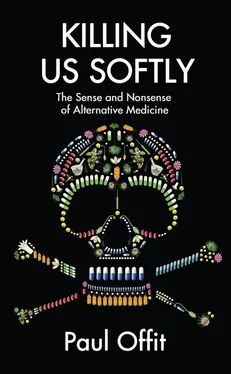Saving Joey Hofbauer Contents Title Page Dedication To all the science writers, science advocates, and science bloggers who have dared proclaim that the emperors of pseudoscience have no clothes Epigraph When religion was strong and science weak, men mistook magic for medicine. Now, when science is strong and religion weak, men mistake medicine for magic. —THOMAS SZASZ Prologue: Taking a Look at Alternative Medicine Introduction: Saving Joey Hofbauer Part I: Distrust of Modern Medicine 1. Rediscovering the Past: Mehmet Oz and His Superstars Part II: The Lure of All Things Natural 2. The Vitamin Craze: Linus Pauling’s Ironic Legacy Part III: Little Supplement Makers Versus Big Pharma 3. The Supplement Industry Gets a Free Pass: Neutering the FDA 4. Fifty-One Thousand New Supplements: Which Ones Work? Part IV: When the Stars Shine on Alternative Medicine 5. Menopause and Aging: Suzanne Somers Weighs In 6. Autism’s Pied Piper: Jenny McCarthy’s Crusade 7. Chronic Lyme Disease: The Blumenthal Affair Part V: The Hope Business 8. Curing Cancer: Steve Jobs, Shark Cartilage, Coffee Enemas, and More 9. Sick Children, Desperate Parents: Stanislaw Burzynski’s Urine Cure Part VI: Charismatic Healers Are Hard to Resist 10. Magic Potions in the Twenty-First Century: Rashid Buttar and the Lure of Personality Part VII: Why Some Alternative Therapies Really Do Work 11. The Remarkably Powerful, Highly Underrated Placebo Response 12. When Alternative Medicine Becomes Quackery Epilogue: Albert Schweitzer and the Witch Doctor: A Parable Notes Selected Bibliography Acknowledgments About the Author Also by Dr Paul Offit Copyright About the Publisher
They were small
And could not hope for help and no help came.
—W. H. Auden, “The Shield of Achilles”
My first exposure to alternative medicine came by way of a story that circulated during my pediatric residency in the late 1970s. It involved a popular alternative cancer remedy called laetrile. Some might read what follows and feel assured it could never happen today—that no parent would ever do such a thing. But every single influence that drove these parents to do what they did is still very much alive, arguably even more so than it was then.
The story concerns a little boy from upstate New York.
On October 5, 1977, Joey Hofbauer complained to his mother about a lump on his neck. When the lump didn’t go away, she took him to their family doctor, Denis Chagnon, who prescribed penicillin, without effect. When the lump got bigger, Chagnon referred Joey to an ear, nose, and throat specialist, Dr. Arthur Cohn, who, on October 25, biopsied it at St. Peter’s Hospital, in Albany. Two days later, Cohn had his diagnosis: Hodgkin’s disease, a cancer of the lymph glands. Joey was seven years old.
Although the news was devastating, Joey’s prognosis was excellent. By the early 1970s, investigators had proved that radiation and chemotherapy offered Joey a 95 percent chance of recovery—with proper treatment, Joey could live a long and fruitful life. But for Joey Hofbauer, the road to recovery wasn’t going to be easy. Within weeks, a battle erupted over how Joey should be treated and by whom. On one side were Joey’s parents, citizen activists, the media, the John Birch Society, and a movie star. On the other were cancer specialists, Senator Edward Kennedy, the Saratoga County Department of Social Services, and the Food and Drug Administration (FDA). The battle lasted three years.
When he learned that Joey had Hodgkin’s disease, Arthur Cohn advised the Hofbauers to see a cancer specialist. The specialist would determine the extent of Joey’s cancer by taking biopsies of the liver and spleen. Then Joey would receive radiation and chemotherapy—medicines like procarbazine, prednisone, vincristine, and nitrogen mustard. Cohn reassured the Hofbauers that their son had an excellent chance of survival. But John and Mary Hofbauer weren’t reassured. They heard words like radiation and chemotherapy , and it scared them, conjuring up images of hair loss, vomiting, diarrhea, anemia, and worse. Certainly there was a better way to treat their son—a more natural way. So they rejected Cohn’s advice and signed Joey out of St. Peter’s Hospital. On November 8, the Hofbauers flew their son to the Fairfield Medical Center, in Montego Bay, Jamaica, to receive a remedy they believed was far gentler, far kinder, and far more reasonable than those recommended by Dr. Cohn: laetrile, a natural remedy made from apricot pits.
The day the Hofbauers flew to Jamaica, Denis Chagnon wrote a letter: “Dear Mr. and Mrs. Hofbauer, I have repeatedly asked for the name and address of a physician to whom I can send [Joey’s] records. I spoke with Mrs. Hofbauer in the morning hours of Friday, November 4th, and again on Monday, November 7th, and was not provided with an answer. Without treatment [Hodgkin’s] disease is oftentimes fatal. I ask you again to provide me with the name and address of his present physician [to] ensure that [Joey] is being properly cared for. If this is not provided by noon, Thursday, November 10th, the following action will be taken: notification of the State Health Department, the Children’s Protective Agency, and the American Cancer Society.” When the Hofbauers left for Jamaica, Chagnon carried out his threat, reporting them to child services. On November 9, the Department of Social Services of Saratoga County, New York, charged John and Mary Hofbauer with neglect, seeking to remove Joey from the home. The law was clear: “The State, under appropriate circumstances, may provide medical care for a minor where the parent or guardian fails to do so.”
On November 23, the Hofbauers returned from Jamaica. Because written and telephone correspondence had been ignored, on November 29, Richard Sheridan and Diana Fenton, from the Department of Social Services—accompanied by an armed sheriff’s deputy—visited the Hofbauers. Sheridan remembered what happened next: “[Mr. Hofbauer said] that we weren’t going to take his child away unless the Sheriff’s deputy drew his gun and arrested him.” Sheridan told Hofbauer that the state of New York was now in charge of Joey’s care. “I told him there was a [hearing],” recalled Sheridan, “and he said it was illegal because he wasn’t there. I said that this was not the place to be talking about this, and Mr. Hofbauer yelled very loudly that it was the place to be talking about this, and he wanted everybody to know that we were coming to take his son.” Hofbauer was convinced that cancer specialists would only harm Joey. “He said I wanted to take his son and poison [him],” said Sheridan. “He said ‘Do you know what chemotherapy is? It’s nitrogen mustard gas. It was declared illegal in the wars.’”
When the dust settled, the Hofbauers relented. Through their lawyer, they worked out a deal. Joey would be taken to St. Peter’s Hospital with an understanding that no diagnostic tests would be performed and no treatment would be administered—at least not until the case could be heard in family court. Joey stayed at St. Peter’s from November 29 to December 9. But John Hofbauer couldn’t watch silently while his son was denied what he believed was a lifesaving medicine. So he secretly gave Joey several doses of laetrile until “we were threatened with armed guards at the door, at which time we desisted.”
In December 1977, the case of Joey Hofbauer was referred to Saratoga Family Court judge Loren N. Brown, who, much to the dismay of child services, agreed to let the Hofbauers treat their son with laetrile for six months. On one condition: they had to find a licensed physician willing to do it. “I had a situation where I had to find a doctor in a hurry,” recalled Hofbauer, “because everybody was demanding to know who my doctor was.” First, Hofbauer asked Dr. Milton Roberts, in Westchester County. But Roberts worried the case had become “too hot to handle,” so he turned him down. Then Hofbauer asked Michael Schachter, a psychiatrist from Nyack, New York. Schachter agreed, but only if the Hofbauers signed a consent form releasing him of all responsibility: “I agree to undergo care with Michael B. Schachter, MD,” it began. “I understand [that] among the substances, medications, or drugs available [laetrile] may be advised for the purpose of metabolic support. The predominant medical view, including that of the Food and Drug Administration (FDA) and the American Medical Association (AMA) is that this substance [has] no known value [for] the treatment of any disease … I understand that some alleged authorities associated with the FDA and AMA assert that the use of this substance constitutes quackery and amounts to a hoax on the American public. I further understand that American physicians have been indicted in California for the use of this substance. I understand that Dr. Michael Schachter [is] not a cancer specialist and [has] no direct experience with the orthodox cancer therapy modalities of chemotherapy, radiation or surgery [and is] not in a position to advise me as to the relative benefits and risks of those treatments for my condition.” On December 14, John and Mary Hofbauer signed Michael Schachter’s consent form.
Читать дальше

![Джейн Остин - Sense and Sensibility [С англо-русским словарем]](/books/26612/dzhejn-ostin-sense-and-sensibility-s-anglo-thumb.webp)
![Edzard Ernst - Trick or Treatment. The Undeniable Facts about Alternative Medicine [Electronic book text]](/books/151762/edzard-ernst-trick-or-treatment-the-undeniable-fa-thumb.webp)









